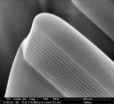(Press-News.org) Researchers at Western University have created a mouse model that reproduces some of the chemical changes in the brain that occur with Alzheimer's, shedding new light on this devastating disease. Marco Prado, Vania Prado and their colleagues at the Schulich School of Medicine & Dentistry's Robarts Research Institute, looked at changes related to a neurotransmitter or chemical messenger, named acetylcholine (ACh), and the kinds of memory problems associated with it. The research is now published online by PNAS.
The researchers, including first author Amanda Martyn, created a mouse line that doesn't have enough ACh being secreted by neurons in the same brain regions affected by Alzheimer's disease. They found this neurochemical failure caused problems with spatial memory, the stored information that is needed for navigating one's environment. For instance, the memory needed to drive across town. They also found the reduction of ACh led to hyperactivity, which many patients with Alzheimer's experience.
"Once we reproduced that neurochemical failure, we asked, 'how does that affect spatial memory, how does it affect learning?' We found mice that don't have that particular chemical messenger in specific areas of the brain, have problems with spatial memory, for example," says Marco Prado. "This reveals specific types of cognitive deficits that we can hope to improve with drugs that boost this chemical messenger."
###This research was funded by the Canadian Institutes of Health Research and PrioNet Canada. Alzheimer's disease affects 5.4 million Americans and more than 500,000 Canadians, and those numbers are expected to climb dramatically as baby boomers age.
Research reveals more about spatial memory problems associated with Alzheimer's
2012-10-10
ELSE PRESS RELEASES FROM THIS DATE:
Photonic gels are colorful sensors
2012-10-10
HOUSTON – (Oct. 10, 2012) – Materials scientists at Rice University and the Massachusetts Institute of Technology (MIT) have created very thin color-changing films that may serve as part of inexpensive sensors for food spoilage or security, multiband optical elements in laser-driven systems and even as part of high-contrast displays.
The new work led by Rice materials scientist Ned Thomas combines polymers into a unique, self-assembled metamaterial that, when exposed to ions in a solution or in the environment, changes color depending on the ions' ability to infiltrate ...
Criteria used to diagnose sports head injuries found to be inconsistent
2012-10-10
In recent years it has become clear that athletes who experience repeated impacts to the head may be at risk of potentially serious neurological and psychiatric problems. But a study of sports programs at three major universities, published in the October 2 Journal of Neurosurgery, finds that the way the injury commonly called concussion is usually diagnosed – largely based on athletes' subjective symptoms – varies greatly and may not be the best way to determine who is at risk for future problems. In addition, the way the term concussion is used in sports injuries may ...
High toll of mental illness and addictions must be addressed
2012-10-10
October 10, 2012 (Toronto) – Mental illnesses and addictions take more of a toll on the health of Ontarians than cancer or infectious diseases, according to a new report by the Institute for Clinical Evaluative Sciences and Public Health Ontario – yet this burden could be reduced with treatment, say scientists from Canada's Centre for Addiction and Mental Health (CAMH).
"The majority of people with mental illness or addiction aren't receiving treatment, even though effective interventions are available," says report co-author Dr. Paul Kurdyak, Chief of General and Health ...
RNA-based therapy brings new hope for an incurable blood cancer
2012-10-10
Three thousand new cases of Mantle Cell Lymphoma (MCL), a form of blood cancer, appear in the United States each year. With a median survival span of only five to seven years, according to the Leukemia and Lymphoma Society, this disease is devastating, and new therapies are sorely needed.
One of the characteristics that defines MCL is heightened activity in the gene CCND1, which leads to the aggressive over-production of Cyclin D1, a protein that controls the proliferation of cells, explains Prof. Dan Peer of Tel Aviv University's Department of Cell Research and Immunology. ...
Squeezing ovarian cancer cells to predict metastatic potential
2012-10-10
New Georgia Tech research shows that cell stiffness could be a valuable clue for doctors as they search for and treat cancerous cells before they're able to spread. The findings, which are published in the journal PLoS One, found that highly metastatic ovarian cancer cells are several times softer than less metastatic ovarian cancer cells.
Assistant Professor Todd Sulchek and Ph.D. student Wenwei Xu used a process called atomic force microscopy (AFM) to study the mechanical properties of various ovarian cell lines. A soft mechanical probe "tapped" healthy, malignant and ...
Effectiveness of HIV pre-exposure prophylaxis in Peru
2012-10-10
In this week's PLOS Medicine, Anna Borquez from Imperial College London and an international group of authors developed a mathematical model representing the HIV epidemic among men who have sex with men (MSM) and transwomen in Lima, Peru as a test-case for the effectiveness of HIV pre-exposure prophylaxis (PrEP). The model was used to investigate the population-level impact, cost, and cost-effectiveness of PrEP under a range of different scenarios. The authors found that strategic PrEP intervention could be a cost-effective addition to existing HIV prevention strategies ...
Most pregnancy-related infections are caused by four treatable conditions
2012-10-10
In low-and-middle income countries, pregnancy-related infections are a major cause of maternal death, can also be fatal to unborn and newborn babies, and are mostly caused by four types of conditions that are treatable and preventable, according to a review by US researchers published in this week's PLOS Medicine.
The authors, led by Michael Gravett and a team of investigators from the University of Washington in Seattle, PATH (Program for Appropriate Technology in Health), and GAPPS (Global Alliance to Prevent Prematurity and Stillbirth, Seattle Children's) reviewed ...
Vigorous physical activity may increase risk of bleeding for children with hemophilia
2012-10-10
CHICAGO – In children and adolescents with hemophilia, vigorous physical activity was associated with an elevated risk of bleeding, although it appears the absolute increase in risk may be small, according to a study in the October 10 issue of JAMA.
Hemophilia is a bleeding disorder that, if untreated, causes recurrent bleeding into joints. "Vigorous physical activity is thought to increase risk of bleeds in children with hemophilia, but the magnitude of the risk is unknown," according to background information in the article. Information about risks associated with ...
Rates of procedures such as angioplasty lower in states with public reporting of outcomes
2012-10-10
CHICAGO – In an analysis that included nearly 100,000 Medicare patients who had experienced a heart attack, the use of a percutaneous coronary intervention (PCI; procedures such as balloon angioplasty or stent placement used to open narrowed coronary arteries) was lower for patients treated in states with public reporting of PCI outcomes compared with patients treated in states without public reporting, with these differences being particularly large in the highest-risk patients, according to a study in the October 10 issue of JAMA. However, the researchers found that there ...
Hormone level linked with increased risk of diabetes, cardiovascular disease, breast cancer, death
2012-10-10
CHICAGO – Plasma levels of proneurotensin are associated with the development of diabetes, cardiovascular disease, cardiovascular and total mortality, and breast cancer in women during long-term follow-up, according to a study in the October 10 issue of JAMA.
Neurotensin, an amino acid peptide primarily expressed in the central nervous system and gastrointestinal tract, regulates both satiety and breast cancer growth in the experimental setting, but little is known about its role in the development of breast cancer or cardiometabolic disease in humans, according to background ...

